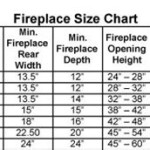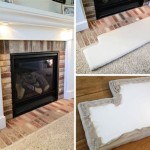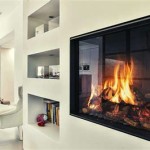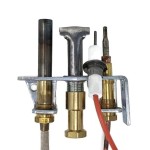Custom Fireplace Insert Surround: Enhancing Aesthetics and Functionality
A fireplace insert is a self-contained heating unit designed to be installed within an existing fireplace opening. It offers a significantly more efficient heating solution compared to traditional open fireplaces. However, the installation of a fireplace insert often leaves a gap or exposed area around the unit, necessitating a surround to complete the look and ensure a seamless integration with the existing interior design. A custom fireplace insert surround provides an opportunity to tailor the appearance of the fireplace to individual preferences and architectural styles, adding value and visual appeal to the home.
The selection of a custom surround involves careful consideration of various factors, including the fireplace insert’s dimensions, the existing fireplace structure, the desired aesthetic, and the budget. Understanding these considerations is crucial to achieving a successful and satisfying outcome.
Understanding the Purpose of a Fireplace Insert Surround
The primary purpose of a fireplace insert surround is multifaceted. First, it is intended to conceal the gap or exposed area around the insert, creating a finished, polished look. This improves the overall aesthetic appeal of the fireplace and the room it occupies. Without a surround, the insert might appear out of place or unfinished, detracting from the room's design.
Second, the surround can offer a degree of protection for the surrounding wall and mantel. The heat generated by the insert can potentially damage or discolor nearby surfaces over time. A surround, particularly one made of non-combustible materials, acts as a buffer, mitigating the risk of heat damage and extending the lifespan of the surrounding structure.
Third, a custom surround allows for personalized design elements that complement the homeowner's style. It provides an opportunity to integrate the fireplace seamlessly into the existing décor, enhancing the overall ambiance of the room. Customization options range from material choices and finishes to intricate designs and architectural details.
Finally, some surrounds can contribute to the overall efficiency of the heating system. By directing the heat output forward and preventing it from escaping around the insert, a well-designed surround can improve the heat distribution within the room.
Key Considerations for Designing a Custom Surround
Designing a custom fireplace insert surround requires a systematic approach, starting with accurate measurements and a clear understanding of the insert's specifications. This involves measuring the height and width of the fireplace opening, as well as the dimensions of the insert itself. The measurements should be precise to ensure a snug and secure fit.
Material selection is another critical consideration. Common materials for fireplace surrounds include wood, stone (such as marble, granite, or slate), metal (such as steel or copper), and tile. Each material offers its unique aesthetic qualities, durability, and heat resistance. Wood, for example, provides a warm and traditional look, but it must be properly treated to withstand the heat generated by the insert. Stone offers a more substantial and elegant appearance and is naturally heat-resistant. Metal provides a modern and industrial aesthetic, while tile allows for a wide range of colors, patterns, and textures.
The style of the surround should complement the existing architectural style of the home. A modern home might benefit from a minimalist surround with clean lines and a sleek finish, while a traditional home might call for a more ornate surround with intricate carvings or moldings. Consider the color palette of the room and choose a surround material and finish that harmonizes with the existing décor. It's also important to factor in the size of the room. A large surround may overwhelm a small room, while a small surround may get lost in a large space.
Budget is a significant factor in any home improvement project. Custom fireplace insert surrounds can range in price depending on the materials used, the complexity of the design, and the labor costs involved. It's crucial to establish a realistic budget before starting the design process and to obtain quotes from multiple contractors or suppliers to ensure that the project remains within budget.
Finally, it is essential to ensure the surround design complies with local building codes and safety regulations. These regulations may specify minimum clearances between the insert and combustible materials, as well as requirements for ventilation and fire protection. Consulting with a qualified contractor or building inspector is highly recommended to ensure compliance and safety.
Material Options and Their Characteristics
The choice of materials significantly impacts the appearance, durability, and functionality of the fireplace insert surround. Understanding the characteristics of each material is essential for making an informed decision.
Wood is a popular choice for its warmth, versatility, and relatively low cost. Wood surrounds can be stained, painted, or finished in a variety of ways to match the existing décor. However, wood is combustible and must be properly treated with a fire-retardant coating to reduce the risk of fire. It is crucial to maintain adequate clearances between the wood surround and the insert to prevent overheating. Hardwoods, such as oak or maple, are generally more durable and heat-resistant than softwoods, such as pine.
Stone offers a more luxurious and durable option. Natural stone, such as marble, granite, and slate, is inherently heat-resistant and adds a touch of elegance to any room. Stone surrounds can be custom-cut and shaped to fit the fireplace opening. However, stone is generally more expensive than wood and requires professional installation due to its weight and complexity. Engineered stone, such as quartz, offers a similar aesthetic to natural stone but is often more affordable and requires less maintenance.
Metal provides a modern and industrial look. Steel, stainless steel, and copper are common choices for metal surrounds. Metal is non-combustible and can withstand high temperatures, making it a safe and durable option. Metal surrounds can be powder-coated or finished in a variety of colors and textures. However, metal can be prone to scratching and denting, and it may require periodic cleaning to maintain its appearance.
Tile offers a wide range of design possibilities. Ceramic, porcelain, and glass tiles are available in a vast array of colors, patterns, and sizes. Tile is heat-resistant and easy to clean, making it a practical choice for fireplace surrounds. Tile can be installed in various configurations, from simple geometric patterns to intricate mosaics. However, tile installation requires specialized skills and tools, and the grout lines may require periodic cleaning to prevent discoloration.
Each material offers a unique set of advantages and disadvantages. The selection should be based on individual preferences, budget, and the specific requirements of the fireplace insert and the surrounding environment. The use of multiple materials in the surround design is also a possibility. A mix of wood and stone, or metal and tile, for example, can create a visually interesting and unique fireplace feature.
The Installation Process and Considerations
The installation of a custom fireplace insert surround is a critical step that requires precision and attention to detail. Proper installation ensures the surround fits correctly, functions safely, and enhances the overall aesthetic appeal of the fireplace. It is crucial to follow the manufacturer's instructions and local building codes throughout the installation process.
Before starting the installation, the fireplace opening should be thoroughly cleaned and prepared. Remove any debris, dust, or loose materials from the opening to ensure a smooth and stable surface for the surround. Verify that the fireplace insert is properly installed and functioning correctly before proceeding with the surround installation.
The installation process will vary depending on the type of surround and the materials used. Wood surrounds typically involve attaching the surround to the fireplace frame using screws or adhesive. Stone surrounds may require a more complex installation process involving mortar and specialized anchoring systems. Metal surrounds may be welded or bolted into place. Tile surrounds typically involve applying mortar to the fireplace surface and setting the tiles in place.
Throughout the installation process, it is essential to maintain accurate measurements and check for proper alignment. Use shims or spacers as needed to ensure the surround is level and plumb. Pay close attention to the clearances between the surround and the fireplace insert. Ensure that adequate ventilation is provided to prevent overheating. After the surround is installed, inspect it carefully for any gaps, cracks, or imperfections. Make any necessary adjustments or repairs to ensure a flawless finish.
Safety is paramount during the installation process. Wear appropriate safety gear, such as gloves, eye protection, and a dust mask. Use caution when lifting heavy materials. If necessary, enlist the help of a qualified professional to assist with the installation. If unsure about any aspect of the installation process, consult with a qualified contractor or building inspector.
Choosing to engage a professional installer can offer numerous benefits, particularly for complex surround designs or when working with heavy or difficult-to-handle materials. Professional installers have the experience, skills, and tools necessary to complete the installation safely and efficiently. They can also ensure that the surround meets all applicable building codes and safety regulations.

Custom Built Fireplace Surround Install A New Mantel Hearth

Fireplace Insert Guide Fireplaces Direct Learning Center

Custom Built Fireplace Surrounds Beautiful Renovations

Gas Insert With Custom Surround Portland Fireplace

Fireplace Insert Surrounds Photos Ideas Houzz

Custom Fireplace Surround Refacing Many Surrounds To Choose From

Fireplace Mantels Mantel Shelves Custom Surrounds And More Direct

Fireplaces Smith May Inc

Fireplace Gallery Pellet Gas Propane Electric Wood

Custom Built Fireplace Surround Install A New Mantel Hearth








